Final report for ONE16-278
Project Information
Organic vegetable growers, such as organic farmers Aimee and John Good of Quiet Creek Farm in Kutztown, are interested in effective weed management techniques that allow them to reduce the frequency of in-season cultivation to manage weed pressure while, enhancing soil health and crop yields. Partnering with the Goods, an experimental and demonstration field trial was established in Kutztown, Pennsylvania in July 2016 to evaluate the effectiveness of chemically- and microbially-designed compost extract (CMD-CE) on weed management in cabbage, lettuce and turnip during the fall season. In a randomized complete block design with four replications, CMD-CE was applied either post-planting or pre- and post-planting and compared to the grower’s standard treatment (in-season cultivation). A no treatment control (no cultivation or compost) was included.
Results showed that soil bulk density did not vary with treatments but it was lower in lettuce (0.8g/cm3) compared to cabbage (1.07 g/cm3). Penetrometer readings were greater in soils that received compost extract (27.58 cm and 28.75 cm; post-planting and pre- and post-planting, respectively) compared to grower treatment (20.04 cm) in cabbage beds. Weed biomass was reduced by 40% in turnip beds that received compost extract when compared to no treatment and by 19% and 34% compared to grower and no treatment, respectively in lettuce beds. Compost extract applications provided comparable lettuce and turnip yield to the grower’s standard method. Applying compost extract was cost effective in the case of turnip followed by lettuce. Project results have been shared with 218 people in person and nearly 100,000 people via social media – Facebook (44k likes), Twitter (48.3k followers), and Instagram (7.5k followers). A web and magazine articles were produced based on the results of this project.
Introduction:
Organic growers rank weeds as the number one obstacle to organic crop production [1]. Weeds compete with crop seeds for water, space, light and nutrients at a faster rate than many crop plants, especially in the first 20-30 days of crop growth [2,3] and have a far greater impact on crop yields than later in the season [4]. Mechanical cultivation and hand weeding are the most widely used weed control methods in organic vegetable production systems. Hand weeding is labor intensive and time consuming. Frequent soil cultivation decreases soil health [5,6]; increases fuel and labor costs [7,8,9]; brings buried weed seeds to the soil surface where they are more likely to germinate and compete with crop plants; and reduces yields and growers’ profits.
Pennsylvania organic vegetable growers are continually on the lookout for practical and cost-effective practices that reduce the severity of weed problems, enhance crop yields, profitability, and sustainability of their livelihood.
In 2014, Dr. Zinati performed proof-of-concept experiments, funded by a private foundation, using CMD-CE to suppress weed seed germination under controlled conditions. Results showed that applications of compost extracts low in nitrate levels and high in nematodes compared to protozoa reduced lambsquarter seed germination by 32% [10, 11] as compared to those without extracts. Other trials showed that pigweed seed germination was suppressed by 20% when compost extracts had lower nematode-to-protozoa ratios [12]. Effectiveness of CMD-CE for weed control has not been tested on growers’ farms and compared to growers’ management practices on a large scale. Collaborating farmers Aimee and John Good face a variety of weed problems during spring and fall seasons. For example, in spring, they consider foxtail and galinsoga to be the major weed species that compete with crops grown without plastic mulch, whereas in the fall, pigweed is a major weed problem. It will be very useful to partner with growers such as Aimee and John Good to evaluate whether the adoption of designed-compost extract would work as an alternative to hand weeding and cultivation and improve soil health and crop yields in spring and fall seasons.
The overarching goal of this project is to find alternative methods for organic weed management that are environmentally- and economically- feasible and deemed practical and available to organic growers.
The specific objectives of this project are to:
-
- Demonstrate that CMD-compost extracts may be used effectively as a weed suppresser to prevent early season weed germination and growth and reduce cultivation and hand weeding;
- Compare costs and benefits of using CMD-compost extracts on crops yields and soil health; and
- Transfer this knowledge to organic growers.
We anticipate that the results of this project will generate data that can be useful to demonstrate to organic growers the suitability and, indirectly, the profitability of using CMD-CE for producing a variety of crops and improving soil health. This project will be the cornerstone to develop and design additional research and education projects to investigate the use of designed compost extracts to suppress weeds with a variety of vegetable crops where growers commonly cultivate in-season to reduce weed pressure.
Cooperators
Research
The project team (the Goods and Dr. Zinati) met in late May 2016 to discuss crop varieties (Turnip ‘Hakurei’; Lettuce ‘Jericho’; and Cabbage ‘Melissa’), establish seedlings in greenhouse and the experimental design and the treatments. Lettuce variety was changed from what was listed in the proposal. The project-team met again in early July to layout the experimental design, flag the treatments for establishing cabbage beds, and discuss the timing for compost extract applications. In late July of 2016, the project-team met to flag and prepared turnip and lettuce beds, and discussed the timing of compost extract applications.
Experimental Site and Design: An on-farm trial was conducted at Kutztown, PA in the fall of 2016 to demonstrate the impact of chemically- and microbially- designed compost extract (CMD-CE) on soil health, crop yield, and weed pressure. Chemical and biological properties of the compost are listed in Table 1.
Table 1. Chemical and biological properties of compost used for preparing extracts. See below.
Compost extracts were prepared at 1:4 dilution (compost:water) for spring application. The compost will be bubbled in water for 24 hours and then used for spraying. Similarly, a 1:3 dilution was prepared for fall application. Similarly, samples of compost extracts will be sent to above-mentioned laboratories for chemical and biological analyses.
In a randomized complete block design with four replications, we established three vegetable crops - cabbage, lettuce and turnip - with four treatments – post-planting CMD-CE application, pre- and post-planting CMD-CE, in-season cultivation (standard), and no cultivation or compost application (no treatment). Soil, weed pressure, and crop yields were evaluated. Aimee and John Good provided soil cultivation, preparation of beds and in-season cultivation (for Grower’s standard treatment).
Field Activities: Compost extracts were prepared 24 hr before application. They were prepared at 1:3 dilution (V:V) using deionized water. They were screened and applied using a backpack sprayer. Cabbage beds were prepared on July 8, 2016. Pre-planting compost extract was applied on July 11, 2016 and cabbage seedlings were transplanted into two-row beds spaced 76 cm between rows and 46 cm spacing within rows on July 13. Post-planting compost extract was applied on July 14, August 3 and 24 of 2016. Cabbage seedlings were covered with row covers immediately after planting. The standard practice of weeding is mechanical cultivation after the removal of row covers. Mechanical cultivation included the flex-tine weeder and duckfoot sweeps. Turnip seeds ‘Hakurei’were directly seeded into 3-row beds, spaced 38 cm between rows with continuous bands of turnip seeds within the row using the Cole planter hand seeder on August 18 of 2016. After seeding, beds are covered with row covers. Hand-hoeing was the weeding method for turnip. Lettuce seedlings were transplanted onto three-row beds with 38 cm centers between rows on August 18, 2016. Compost extract was applied pre-plant one day before seeding turnip and transplanting lettuce, while post-plant extract application occurred on August 19, 2016 for turnip and lettuce and on September 16, 2016 for lettuce only.
Data collection: After one in-season cultivation in cabbage and hand hoeing in turnip and lettuce, weeds were collected from random 0.5m square meter quadrats in the middle rows per treatment and assessed for density (#/ha), biomass (kg/ha), and diversity just before first harvest of tested crops.
Turnips were harvested on September 28 and October 7 of 2016. Total number and weight of marketable turnip bulbs were recorded.
Lettuce heads were harvested from all plots on October 7, 2016. Lettuce heads were cut at the crown level and counted per treatment and yield was recorded.
Cabbage heads were harvested on four occasions: October 13, 24, November 4 and 18 of 2016. Some of the cabbage heads that were not ready for harvest on November 4 were given more time to grow and fill as weather warmed up. Cabbage heads were cut at the crown level and counted per treatment and yield was recorded.
Soil physical properties such as soil bulk density and compaction were measured in samples collected from each treatment. Soil bulk density and soil compaction were assessed at end of the season per crop. The depths at which soil penetrometer readings were 300 psi were recorded and the averages of three readings per each treatment were used to determine the depths where root growth would be restricted. Additional sets of soil samples were collected and sent to commercial laboratories for chemical and biological assessments. Vegetable crops were harvested and assessed for weight and quantity.
Statistical analysis: Data were analyzed by one way ANOVA in general linear model to test significance between treatments using Tukey’s post hoc test and SAS 9.3 software [13].
Cost analysis: Hours spent hoeing and conducting in-season cultivation or applying compost extracts were quantified to estimate the cost and benefit ratios of the proposed treatment with impacts on soil health and crop yields as additional variables.
Outreach: The field site was open for visitors, students and interns to gain knowledge and hands-on training on compost preparation, application, weed counts, soil sampling, and impacts of each treatment on weeds and crop yield.

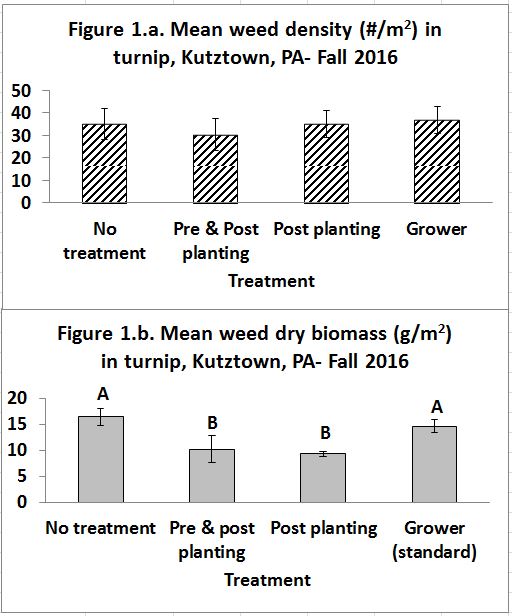
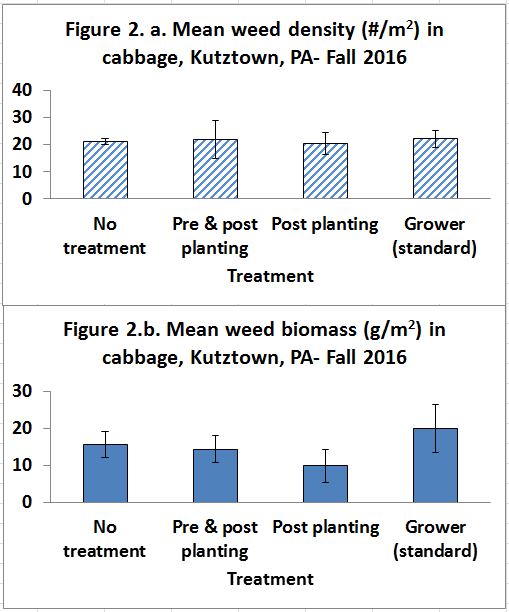
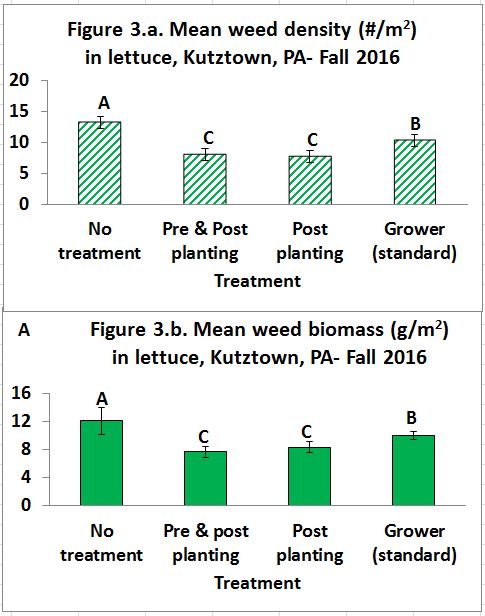
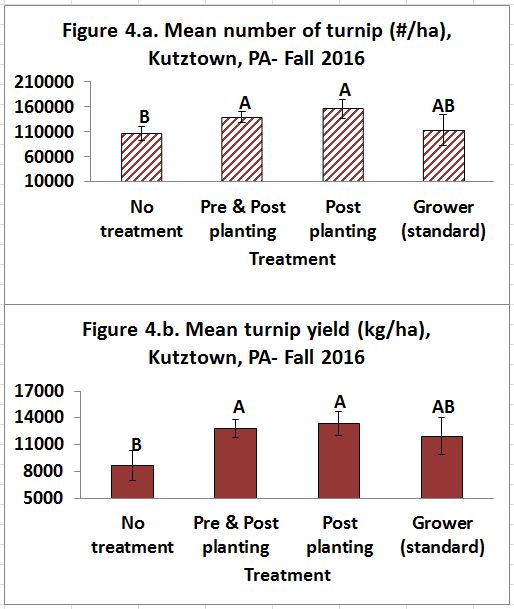
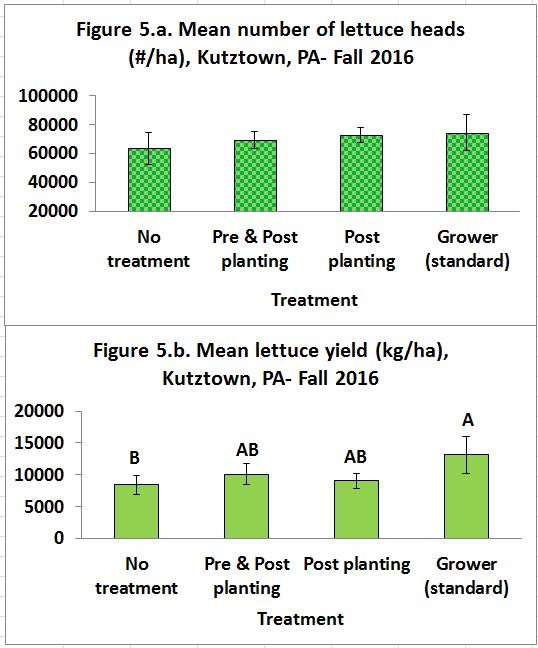
Weed biomass, density and diversity: While there was no significant difference in weed density between treatments in turnip (Figure 1.a), weed biomass was 43% lower when compost extract was applied as a post-planting and 38% when applied pre and post-planting compared to no treatment while the in-season cultivation reduced weed biomass by 11% only (Figure 1.b). The weeds were diverse and mainly included Pennsylvania smart weed, galinsoga, purslane, and wild radish. In no treatment plots pigweed and galinsoga were the major weeds. All treatments had grass weeds. In cabbage beds, weed density was similar in all tested treatments (Figure 2.a). Weed biomass was lower in treatments that received compost extract post-planting but not significantly different compared to grower treatment or no treatment (Figure 2.b). The weeds were mainly broad leaf weeds such as plantain, galinsoga and aster. All treatments had grass weeds including nutsedge except the grower treatment. This could be due to in-season cultivation that reduced grass and nutsedge population. In lettuce beds, weed density was significantly lower in treatments that received compost extracts than in no treatment or grower treatment (Figure 3.a). The use of compost extract reduced weed biomass by 19% and 34%, respectively, compared to grower’s treatment and no treatment. Major broadleaf weeds included mustard, galinsoga, and wild radish. Similarly to turnip and cabbage, grasses were lower in grower treatment due to hoeing.
Crop yield: Mean turnip number (Figure 4.a.) and mean yield (Figure 4.b) were significantly greater in treatments that received compost extracts than no treatment and not different from grower treatment. For lettuce, number of heads ranged between 63,000 heads/ha (no treatment) and 74,000 heads/ha (grower treatment) and were not significantly different from treatments that received compost extracts (averaging 70,000) (Figure 5.a). Lettuce yield was significantly greater in grower treatment than in no treatment and not different from those treated with compost extract (Figure 5.b). There was no significant difference in either number of cabbage heads or yield per treatment. Cabbage heads ranged between 30,000 and 35,000 heads per hectare and yield ranged between 11,500 to 13,800 kg per ha.
Soil physical and chemical properties: Soil bulk density was determined in lettuce and cabbage beds only. In lettuce, mean soil bulk density was 0.8 g/cm3, whereas in cabbage mean soil bulk density was 1.07 g/cm3. There was no significant difference in soil compaction in lettuce beds (mean value 22 cm). However, in cabbage beds mean penetrometer readings were 20.04 cm in grower treatment (in-season cultivation) and no treatment (21.33 cm) and were significantly different from penetrometer readings taken in soils that received compost extract (27.58 cm and 28.75 cm; post-planting and pre- and post-planting, respectively). These results illustrate that using in-season cultivation for weed management increases compaction after only one growing season when compared to soils that receives compost extract, as an alternative method for managing weeds. Soil chemical properties: No major changes in soil nutrients except in phosphorus and potassium. Mean soil phosphorus concentration (ranged between 71 and 82 ppm) at the end of the season was greater by 15% in all treatments than that at the beginning of the season (ranged between 60 and 67 ppm). However, mean potassium concentration at the end of season decreased by 43% from that at the beginning of the season (ranged between 146 ppm and 161 ppm).
Soil biological properties: Results showed that soils collected from plots that received compost extracts had mean values of biological properties not different from those in grower standard treatment (Table 2). However, mean values of biological properties were consistently lower in no treatment. Thus, the use of pre- and post- planting compost extracts as an alternative to the grower’s standard method can be beneficial for weed management and conserving soil biological properties.
Table 2. Mean values of soil total, bacterial, fungal and protozoan biomass as they varied with treatments.
|
Treatment |
Total Biomass |
Total Bacteria Biomass |
Total Fungi Biomass |
Protozoa Biomass |
Undifferentiated Biomass |
|
No treatment |
3,888 |
1,961 |
423 |
32 |
1,472 |
|
Pre & post planting |
5,468 |
2,544 |
589 |
44 |
2,291 |
|
Post planting |
4,368 |
2,147 |
488 |
38 |
1,695 |
|
Grower |
4,935 |
2,722 |
629 |
55 |
1,529 |
Literature-CitedAccomplishments
ECONOMIC ANALYSIS
In this project, we demonstrated the effectiveness of the proposed method of using CMD-compost extracts at 1:3 dilution in reducing weed expression, and thus reducing cultivation and time spent on hand weeding and its potential integration into organic management cropping systems.
The economic analysis was based on certain assumptions such as the cost of fuel and time spent for in-season cultivation ($40 per half hour for an area of 120 m2) as well as the wage per person ($15 per hour) to either apply compost extract or hand hoeing. It took one person for two hours (backpack sprayer) to apply compost extract on 120 m2. Four people for an hour hand-hoed an area of 120 m2 for each of turnip and lettuce.
The use of designed compost extracts at 1:3 dilutions can serve as an alternative method for weed management and can be considered a cost effective system for fall-season turnip production followed by lettuce (Table 3). While this approach could conserve soil health, it can become less cost effective when compost extracts are applied over three times per season due to labor cost.
Table 3. Cost analysis for standard method of weed management versus compost extract applications for each of cabbage, lettuce and turnip.
|
Cost ($) |
|||
|
Weed management treatment |
Cabbage |
Lettuce |
Turnip |
|
In-season cultivation |
40 |
0 |
0 |
|
Compost extracts application† |
120 |
90 |
60 |
|
Hand hoeing |
0 |
60 |
60 |
†Compost extracts application times: Cabbage-four, lettuce- three, and turnip: two.
CONCLUSION
Growers were very interested in learning about the alternative options of using designed compost extracts for weed management in organic farming. Results from this project verified the concept of using designed compost extracts at 1:3 dilutions to reduce soil compaction, produce comparable crop yields as those produced using the grower standard method, and can be cost-effective when compost extract applications did not exceed three applications per season.
In summary, the results from this project provided insight on how compost extracts can be useful in managing weeds and increasing crop yields in comparison to growers’ standard methods that include hand-hoeing and in-season cultivation. Thus, compost extracts have the potential to manage a variety of weeds based on timing of the season, frequency of application and crop habits.
New and young growers with limited finances, labor, tools, and equipment could benefit from using designed compost extracts when growing organic vegetable crops. Organic growers who have access to making compost have the potential to manage weeds, improve soil health and increase yields.
PUBLICATIONS/OUTREACH
Outreach activities:
- July 15, 2016- About 182 people attended the field day and about 110 people were provided with information on the concept of using designed compost extract for soil conservation and weed control for cabbage.
- July 20, 2016- The CRAFT group of 25 participants visited the site and information on how compost extract can be considered as one tool in the tool box for no-till plant production was discussed.
- July 30, 2016- Information on the project and a demonstration of compost extract preparation were provided to a group of 55 students from Lehigh University.
- September 9, 2016- Two growers from Alabama and Pennsylvania visited the site and were provided with information regarding project objectives and the impacts of using designed compost extracts as alternative to cultivation for weed suppression.
- October 4, 2016- A group of 6 people from the Hudson Valley Farm Hub toured the experimental field site and were shown the impact of treatments.
- November 8, 2016- Dr. Zinati made a poster presentation at the American Society of Agronomy (ASA) in Phoenix, AZ. Fifteen attendees visited her poster and showed interest in the project concept and the successful results of using compost extracts for weed suppression. A tweet of this poster was seen 2,463 times and reached at least 48.3k and a press release was published on Rodale Institute’s website on the poster presentation on November 19, 2016 http://rodaleinstitute.org/rodale-institute-at-agronomy-crop-soil-science-conference/
- December 15, 2016- Information about the project was shared with two representatives from Pacific Foods and three Chinese delegates from IFOAM.
- A web article posted on Rodale Institute’s website, June 15, 2017 http://rodaleinstitute.org/use-of-chemically-and-microbially-designed-compost-extracts-for-managing-weeds/
- An article was submitted to BioCycle trade magazine and will be published in July issue of 2017.
Education & outreach activities and participation summary
Participation summary:
Outreach activities:
- July 15, 2016- About 182 people attended the field day and about 110 people were provided with information on the concept of using designed compost extract for soil conservation and weed control for cabbage.
- July 20, 2016- The CRAFT group of 25 participants visited the site and information on how compost extract can be considered as one tool in the tool box for no-till plant production was discussed.
- July 30, 2016- Information on the project and a demonstration of compost extract preparation were provided to a group of 55 students from Lehigh University.
- September 9, 2016- Two growers from Alabama and Pennsylvania visited the site and were provided with information regarding project objectives and the impacts of using designed compost extracts as alternative to cultivation for weed suppression.
- October 4, 2016- A group of 6 people from the Hudson Valley Farm Hub toured the experimental field site and were shown the impact of treatments.
- November 8, 2016- Dr. Zinati made a poster presentation at the American Society of Agronomy (ASA) in Phoenix, AZ. Fifteen attendees visited her poster and showed interest in the project concept and the successful results of using compost extracts for weed suppression. A tweet of this poster was seen 2,463 times and reached at least 48.3k and a press release was published on Rodale Institute’s website on the poster presentation on November 19, 2016 http://rodaleinstitute.org/rodale-institute-at-agronomy-crop-soil-science-conference/
- December 15, 2016- Information about the project was shared with two representatives from Pacific Foods and three Chinese delegates from IFOAM.
- A web article posted on Rodale Institute’s website, June 15, 2017 http://rodaleinstitute.org/use-of-chemically-and-microbially-designed-compost-extracts-for-managing-weeds/
- An article was submitted to BioCycle trade magazine and will be published in July issue of 2017.
Learning Outcomes
Each reported gaining knowledge and awareness of beneficial effects of using design compost extracts to manage weeds as an alternative to cultivation or hand-hoeing.
Project Outcomes
Impacts
Our outreach and education activities related to the project reached about 200 growers and 55 students, as well as at least 10 military veteran farmer trainees and interns. Growers were very interested in learning about the alternative options of using designed compost extracts for weed management in organic farming. Results from this project verified the concept of using designed compost extracts at 1:3 dilutions to reduce soil compaction, produce comparable crop yields as those produced using the grower standard method, and can be cost-effective when compost extract applications did not exceed three applications per season.
In summary, the results from this project provided insight on how compost extracts can be useful in managing weeds and increasing crop yields in comparison to growers’ standard methods that include hand-hoeing and in-season cultivation. Thus, compost extracts have the potential to manage a variety of weeds based on timing of the season, frequency of application and crop habits.
New and young growers with limited finances, labor, tools, and equipment could benefit from using designed compost extracts when growing organic vegetable crops. Organic growers who have access to making compost have the potential to manage weeds, improve soil health and increase yields.
In this study we only tested three crops grown on bare ground. However, additional studies are needed to evaluate the impact of number of applications of CMD compost extracts for a variety of crops that are grown in spring and fall seasons on weed management, crop yield and quality, and soil health.